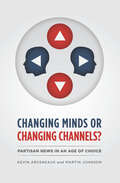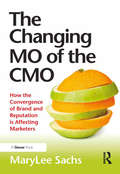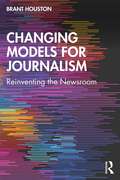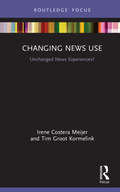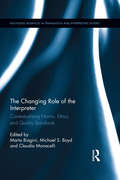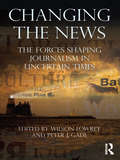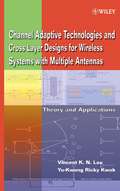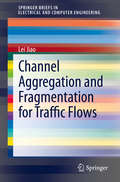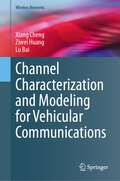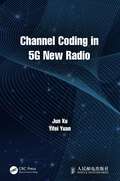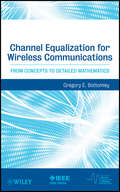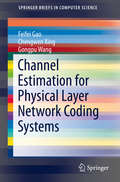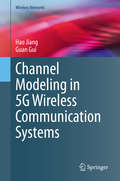- Table View
- List View
Changing Minds or Changing Channels?: Partisan News in an Age of Choice (Chicago Studies in American Politics)
by Kevin Arceneaux Martin JohnsonWe live in an age of media saturation, where with a few clicks of the remote—or mouse—we can tune in to programming where the facts fit our ideological predispositions. But what are the political consequences of this vast landscape of media choice? Partisan news has been roundly castigated for reinforcing prior beliefs and contributing to the highly polarized political environment we have today, but there is little evidence to support this claim, and much of what we know about the impact of news media come from studies that were conducted at a time when viewers chose from among six channels rather than scores. Through a series of innovative experiments, Kevin Arceneaux and Martin Johnson show that such criticism is unfounded. Americans who watch cable news are already polarized, and their exposure to partisan programming of their choice has little influence on their political positions. In fact, the opposite is true: viewers become more polarized when forced to watch programming that opposes their beliefs. A much more troubling consequence of the ever-expanding media environment, the authors show, is that it has allowed people to tune out the news: the four top-rated partisan news programs draw a mere three percent of the total number of people watching television. Overturning much of the conventional wisdom, Changing Minds or Changing Channels? demonstrate that the strong effects of media exposure found in past research are simply not applicable in today’s more saturated media landscape.
Changing Minds or Changing Channels?: Partisan News in an Age of Choice (Chicago Studies in American Politics)
by Kevin Arceneaux Martin JohnsonWe live in an age of media saturation, where with a few clicks of the remote—or mouse—we can tune in to programming where the facts fit our ideological predispositions. But what are the political consequences of this vast landscape of media choice? Partisan news has been roundly castigated for reinforcing prior beliefs and contributing to the highly polarized political environment we have today, but there is little evidence to support this claim, and much of what we know about the impact of news media come from studies that were conducted at a time when viewers chose from among six channels rather than scores. Through a series of innovative experiments, Kevin Arceneaux and Martin Johnson show that such criticism is unfounded. Americans who watch cable news are already polarized, and their exposure to partisan programming of their choice has little influence on their political positions. In fact, the opposite is true: viewers become more polarized when forced to watch programming that opposes their beliefs. A much more troubling consequence of the ever-expanding media environment, the authors show, is that it has allowed people to tune out the news: the four top-rated partisan news programs draw a mere three percent of the total number of people watching television. Overturning much of the conventional wisdom, Changing Minds or Changing Channels? demonstrate that the strong effects of media exposure found in past research are simply not applicable in today’s more saturated media landscape.
Changing Minds or Changing Channels?: Partisan News in an Age of Choice (Chicago Studies in American Politics)
by Kevin Arceneaux Martin JohnsonWe live in an age of media saturation, where with a few clicks of the remote—or mouse—we can tune in to programming where the facts fit our ideological predispositions. But what are the political consequences of this vast landscape of media choice? Partisan news has been roundly castigated for reinforcing prior beliefs and contributing to the highly polarized political environment we have today, but there is little evidence to support this claim, and much of what we know about the impact of news media come from studies that were conducted at a time when viewers chose from among six channels rather than scores. Through a series of innovative experiments, Kevin Arceneaux and Martin Johnson show that such criticism is unfounded. Americans who watch cable news are already polarized, and their exposure to partisan programming of their choice has little influence on their political positions. In fact, the opposite is true: viewers become more polarized when forced to watch programming that opposes their beliefs. A much more troubling consequence of the ever-expanding media environment, the authors show, is that it has allowed people to tune out the news: the four top-rated partisan news programs draw a mere three percent of the total number of people watching television. Overturning much of the conventional wisdom, Changing Minds or Changing Channels? demonstrate that the strong effects of media exposure found in past research are simply not applicable in today’s more saturated media landscape.
Changing Minds or Changing Channels?: Partisan News in an Age of Choice (Chicago Studies in American Politics)
by Kevin Arceneaux Martin JohnsonWe live in an age of media saturation, where with a few clicks of the remote—or mouse—we can tune in to programming where the facts fit our ideological predispositions. But what are the political consequences of this vast landscape of media choice? Partisan news has been roundly castigated for reinforcing prior beliefs and contributing to the highly polarized political environment we have today, but there is little evidence to support this claim, and much of what we know about the impact of news media come from studies that were conducted at a time when viewers chose from among six channels rather than scores. Through a series of innovative experiments, Kevin Arceneaux and Martin Johnson show that such criticism is unfounded. Americans who watch cable news are already polarized, and their exposure to partisan programming of their choice has little influence on their political positions. In fact, the opposite is true: viewers become more polarized when forced to watch programming that opposes their beliefs. A much more troubling consequence of the ever-expanding media environment, the authors show, is that it has allowed people to tune out the news: the four top-rated partisan news programs draw a mere three percent of the total number of people watching television. Overturning much of the conventional wisdom, Changing Minds or Changing Channels? demonstrate that the strong effects of media exposure found in past research are simply not applicable in today’s more saturated media landscape.
Changing Minds or Changing Channels?: Partisan News in an Age of Choice (Chicago Studies in American Politics)
by Kevin Arceneaux Martin JohnsonWe live in an age of media saturation, where with a few clicks of the remote—or mouse—we can tune in to programming where the facts fit our ideological predispositions. But what are the political consequences of this vast landscape of media choice? Partisan news has been roundly castigated for reinforcing prior beliefs and contributing to the highly polarized political environment we have today, but there is little evidence to support this claim, and much of what we know about the impact of news media come from studies that were conducted at a time when viewers chose from among six channels rather than scores. Through a series of innovative experiments, Kevin Arceneaux and Martin Johnson show that such criticism is unfounded. Americans who watch cable news are already polarized, and their exposure to partisan programming of their choice has little influence on their political positions. In fact, the opposite is true: viewers become more polarized when forced to watch programming that opposes their beliefs. A much more troubling consequence of the ever-expanding media environment, the authors show, is that it has allowed people to tune out the news: the four top-rated partisan news programs draw a mere three percent of the total number of people watching television. Overturning much of the conventional wisdom, Changing Minds or Changing Channels? demonstrate that the strong effects of media exposure found in past research are simply not applicable in today’s more saturated media landscape.
Changing Minds or Changing Channels?: Partisan News in an Age of Choice (Chicago Studies in American Politics)
by Kevin Arceneaux Martin JohnsonWe live in an age of media saturation, where with a few clicks of the remote—or mouse—we can tune in to programming where the facts fit our ideological predispositions. But what are the political consequences of this vast landscape of media choice? Partisan news has been roundly castigated for reinforcing prior beliefs and contributing to the highly polarized political environment we have today, but there is little evidence to support this claim, and much of what we know about the impact of news media come from studies that were conducted at a time when viewers chose from among six channels rather than scores. Through a series of innovative experiments, Kevin Arceneaux and Martin Johnson show that such criticism is unfounded. Americans who watch cable news are already polarized, and their exposure to partisan programming of their choice has little influence on their political positions. In fact, the opposite is true: viewers become more polarized when forced to watch programming that opposes their beliefs. A much more troubling consequence of the ever-expanding media environment, the authors show, is that it has allowed people to tune out the news: the four top-rated partisan news programs draw a mere three percent of the total number of people watching television. Overturning much of the conventional wisdom, Changing Minds or Changing Channels? demonstrate that the strong effects of media exposure found in past research are simply not applicable in today’s more saturated media landscape.
The Changing MO of the CMO: How the Convergence of Brand and Reputation is Affecting Marketers
by MaryLee SachsMaryLee Sachs explores the relationship and increasing blur between the marketing discipline and the public relations profession. How do the two mix? What is their role in a world where the growth of digital and social media has contributed to an increasing lack of control over how brands are perceived? Drawing on the experiences of Chief Marketing Officers (CMOs) from 10 iconic organizations with business and consumer brands across the globe, The Changing MO of the CMO explores how some organizations are making the most of a blended approach to communications and marketing and how CMOs can respond to and prepare for their new responsibilities. It illustrates how PR can provide: ¢ authenticity, relevance and advocacy to marketing; ¢ integration of an organization's approach to paid, owned and earned media channels; ¢ a strategic risk management tool for assuring reputation and managing crisis communication. Changing the traditional roles of marketing and communications may be an imperative for organizations. That doesn't make it easy. This readable and credible short guide provides a sense of the opportunities and obstacles involved and the vision required to change the culture of marketing and communications. The Changing MO of the CMO is an important book for developing a new model of marketing; it should be read by all CMOs charged with defining and implementing changes.
The Changing MO of the CMO: How the Convergence of Brand and Reputation is Affecting Marketers
by MaryLee SachsMaryLee Sachs explores the relationship and increasing blur between the marketing discipline and the public relations profession. How do the two mix? What is their role in a world where the growth of digital and social media has contributed to an increasing lack of control over how brands are perceived? Drawing on the experiences of Chief Marketing Officers (CMOs) from 10 iconic organizations with business and consumer brands across the globe, The Changing MO of the CMO explores how some organizations are making the most of a blended approach to communications and marketing and how CMOs can respond to and prepare for their new responsibilities. It illustrates how PR can provide: ¢ authenticity, relevance and advocacy to marketing; ¢ integration of an organization's approach to paid, owned and earned media channels; ¢ a strategic risk management tool for assuring reputation and managing crisis communication. Changing the traditional roles of marketing and communications may be an imperative for organizations. That doesn't make it easy. This readable and credible short guide provides a sense of the opportunities and obstacles involved and the vision required to change the culture of marketing and communications. The Changing MO of the CMO is an important book for developing a new model of marketing; it should be read by all CMOs charged with defining and implementing changes.
Changing Models for Journalism: Reinventing the Newsroom
by Brant HoustonExploring the deep transformation that journalism has undergone in the last decade, this book provides students, professors and working journalists with the background on the demise of traditional media in the U.S. and the changes happening in the digital newsrooms. Houston discusses today’s changes in journalism in the U.S., comparing and contrasting them with those around the world. Topics discussed include the decimation of the traditional newsrooms, contemporary corporate ownership and investors, the rise of bloggers and digital journalism, finding new audiences, the surge in nonprofit newsrooms and collaborations, investigative centers in the U.S. and globally, new model start-ups, and changing streams of revenue with the expansion of new technologies. The text also looks at the new relationship between journalism professionals and the academy, including the rise in content and stories supplied by university-based newsrooms. Houston, who has been on the frontline of these changes, also discusses the culture clashes and ethical dilemmas in cyber environments accompanied by new challenges to maintaining credibility and creating trust. To fully explore the rapid-fire changes in news media and online journalism in recent years, this book will be of interest to students of journalism and communications, working journalists, and professors helping prepare budding journalists for their future careers in journalism.
Changing Models for Journalism: Reinventing the Newsroom
by Brant HoustonExploring the deep transformation that journalism has undergone in the last decade, this book provides students, professors and working journalists with the background on the demise of traditional media in the U.S. and the changes happening in the digital newsrooms. Houston discusses today’s changes in journalism in the U.S., comparing and contrasting them with those around the world. Topics discussed include the decimation of the traditional newsrooms, contemporary corporate ownership and investors, the rise of bloggers and digital journalism, finding new audiences, the surge in nonprofit newsrooms and collaborations, investigative centers in the U.S. and globally, new model start-ups, and changing streams of revenue with the expansion of new technologies. The text also looks at the new relationship between journalism professionals and the academy, including the rise in content and stories supplied by university-based newsrooms. Houston, who has been on the frontline of these changes, also discusses the culture clashes and ethical dilemmas in cyber environments accompanied by new challenges to maintaining credibility and creating trust. To fully explore the rapid-fire changes in news media and online journalism in recent years, this book will be of interest to students of journalism and communications, working journalists, and professors helping prepare budding journalists for their future careers in journalism.
Changing News Use: Unchanged News Experiences? (Disruptions)
by Irene Costera Meijer Tim Groot KormelinkChanging News Use pulls from empirical research to introduce and describehow changing news user patterns and journalism practices have beenmutually disruptive, exploring what journalists and the news media canlearn from these changes. Based on 15 years of audience research, the authors provide an in-depthdescription of what people do with news and how this has diversifiedover time, from reading, watching, and listening to a broader spectrumof user practices including checking, scrolling, tagging, and avoiding.By emphasizing people’s own experience of journalism, this book alsoinvestigates what two prominent audience measurements – clicking andspending time – mean from a user perspective. The book outlines ways toovercome the dilemma of providing what people apparently want (attentiongrabbingnews features) and delivering what people apparently need (whatjournalists see as important information), suggesting alternative ways toinvestigate and become sensitive to the practices, preferences, and pleasuresof audiences and discussing what these research findings might mean foreveryday journalism practice. The book is a valuable and timely resource for academics and researchersinterested in the fields of journalism studies, sociology, digital media, andcommunication.
Changing News Use: Unchanged News Experiences? (Disruptions)
by Irene Costera Meijer Tim Groot KormelinkChanging News Use pulls from empirical research to introduce and describehow changing news user patterns and journalism practices have beenmutually disruptive, exploring what journalists and the news media canlearn from these changes. Based on 15 years of audience research, the authors provide an in-depthdescription of what people do with news and how this has diversifiedover time, from reading, watching, and listening to a broader spectrumof user practices including checking, scrolling, tagging, and avoiding.By emphasizing people’s own experience of journalism, this book alsoinvestigates what two prominent audience measurements – clicking andspending time – mean from a user perspective. The book outlines ways toovercome the dilemma of providing what people apparently want (attentiongrabbingnews features) and delivering what people apparently need (whatjournalists see as important information), suggesting alternative ways toinvestigate and become sensitive to the practices, preferences, and pleasuresof audiences and discussing what these research findings might mean foreveryday journalism practice. The book is a valuable and timely resource for academics and researchersinterested in the fields of journalism studies, sociology, digital media, andcommunication.
The Changing Role of the Interpreter: Contextualising Norms, Ethics and Quality Standards (Routledge Advances in Translation and Interpreting Studies)
by Marta Biagini Michael S. Boyd Claudia MonacelliThis volume provides a critical examination of quality in the interpreting profession by deconstructing the complex relationship between professional norms and ethical considerations in a variety of sociocultural contexts. Over the past two decades the profession has compelled scholars and practitioners to take into account numerous factors concerning the provision and fulfilment of interpreting. Building on ideas that began to take shape during an international conference on interpreter-mediated interactions, commemorating Miriam Shlesinger, held in Rome in 2013, the book explores some of these issues by looking at the notion of quality through interpreters’ self-awareness of norms at work across a variety of professional settings, contextualising norms and quality in relation to ethical behaviour in everyday practice. Contributions from top researchers in the field create a comprehensive picture of the dynamic role of the interpreter as it has evolved, with key topics revisited by the addition of new contributions from established scholars in the field, fostering discussion and further reflection on important issues in the field of interpreting. This volume will be key reading for scholars, researchers, and graduate students in interpreting and translation studies, pragmatics, discourse analysis, and multilingualism.
The Changing Role of the Interpreter: Contextualising Norms, Ethics and Quality Standards (Routledge Advances in Translation and Interpreting Studies)
by Marta Biagini Michael S. Boyd Claudia MonacelliThis volume provides a critical examination of quality in the interpreting profession by deconstructing the complex relationship between professional norms and ethical considerations in a variety of sociocultural contexts. Over the past two decades the profession has compelled scholars and practitioners to take into account numerous factors concerning the provision and fulfilment of interpreting. Building on ideas that began to take shape during an international conference on interpreter-mediated interactions, commemorating Miriam Shlesinger, held in Rome in 2013, the book explores some of these issues by looking at the notion of quality through interpreters’ self-awareness of norms at work across a variety of professional settings, contextualising norms and quality in relation to ethical behaviour in everyday practice. Contributions from top researchers in the field create a comprehensive picture of the dynamic role of the interpreter as it has evolved, with key topics revisited by the addition of new contributions from established scholars in the field, fostering discussion and further reflection on important issues in the field of interpreting. This volume will be key reading for scholars, researchers, and graduate students in interpreting and translation studies, pragmatics, discourse analysis, and multilingualism.
Changing the News: The Forces Shaping Journalism in Uncertain Times (Routledge Communication Series)
by Wilson Lowrey Peter J. GadeChanging the News examines the difficulties in changing news processes and practices in response to the evolving circumstances and struggles of the journalism industry. The editors have put together this volume to demonstrate why the prescriptions employed to salvage the journalism industry to date haven’t worked, and to explain how constraints and pressures have influenced the field’s responses to challenges in an uncertain, changing environment. If journalism is to adjust and thrive, the following questions need answers: Why do journalists and news organizations respond to uncertainties in the ways they do? What forces and structures constrain these responses? What social and cultural contexts should we take into account when we judge whether or not journalism successfully responds and adapts? The book tackles these questions from varying perspectives and levels of analysis, through chapters by scholars of news sociology and media management. Changing the News details the forces that shape and challenge journalism and journalistic culture, and explains why journalists and their organizations respond to troubles, challenges and uncertainties in the way they do.
Changing the News: The Forces Shaping Journalism in Uncertain Times (Routledge Communication Series)
by Wilson Lowrey Peter J. GadeChanging the News examines the difficulties in changing news processes and practices in response to the evolving circumstances and struggles of the journalism industry. The editors have put together this volume to demonstrate why the prescriptions employed to salvage the journalism industry to date haven’t worked, and to explain how constraints and pressures have influenced the field’s responses to challenges in an uncertain, changing environment. If journalism is to adjust and thrive, the following questions need answers: Why do journalists and news organizations respond to uncertainties in the ways they do? What forces and structures constrain these responses? What social and cultural contexts should we take into account when we judge whether or not journalism successfully responds and adapts? The book tackles these questions from varying perspectives and levels of analysis, through chapters by scholars of news sociology and media management. Changing the News details the forces that shape and challenge journalism and journalistic culture, and explains why journalists and their organizations respond to troubles, challenges and uncertainties in the way they do.
Channel-Adaptive Technologies and Cross-Layer Designs for Wireless Systems with Multiple Antennas: Theory and Applications (Wiley Series in Telecommunications and Signal Processing #85)
by Vincent K.N. Lau Yu-Kwong Ricky KwokThis innovative book sets forth two promising wireless approaches that support high-quality, high-speed data and multimedia service-multiple antenna technologies and cross layer transmitter adaptation designs-while highlighting the relationships and interactions between them. The latest advanced technologies of channel adaptation techniques for wireless communication systems with multiple antennas are thoroughly investigated. The book is divided into three parts, first giving readers a good foundation in underlying theory, then exploring applications as well as advanced topics: * Part 1 examines theoretical aspects of channel adaptation in wireless communications for point-to-point and multi-user systems with multiple antennas * Part 2 focuses on the applications of the channel-adaptive technologies in practical systems such as UMTS * Part 3 delves into topics such as multi-user scheduling for wideband systems, combined queuing theory and information theory, and ad hoc routing Using a hands-on, practical approach, Channel Adaptive Technologies and Cross Layer Designs for Wireless Systems with Multiple Antennas thoroughly covers detailed design considerations that help readers understand how to apply theory to real-world systems. Emphasis throughout the book is on joint optimization across different layers of a communications system based on an integrated approach. Examples of popular wireless systems, such as TDMA, wideband CDMA (UMTS), and HSDPA, are used throughout as practical illustrations. Each chapter ends with a summary that reviews key points and a set of problems that lets readers test their knowledge and continue to develop their skills as they progress to new topics. Figures and tables are also used extensively to help readers visualize complex theory and systems. Combining theory, design, and application into one integrated approach, this is a superior reference for advanced communications theory courses.
Channel Aggregation and Fragmentation for Traffic Flows (SpringerBriefs in Electrical and Computer Engineering)
by Lei JiaoThis book introduces the impact of channel aggregation (CA) and channel fragmentation (CF) on traffic flows, through analytical models, computer simulations, and test-bed implementations. Its content includes the concept of CA and CF, the basic concept and calculation of Markov chains (MCs), the modeling process of the CA and CF enabled system via MCs, the process of simulations, and a test-bed study based on a software defined radio.This book can serve as a study guide for advanced-level students, who are interested in studying the impact of CA and CF techniques on traffic flows. This book would also interest communication engineers, who would like to learn MC modeling for performance evaluations, as it includes a step-by-step guidance for the modeling process via MCs, as well as its simulation approaches.
Channel Characterization and Modeling for Vehicular Communications (Wireless Networks)
by Xiang Cheng Ziwei Huang Lu BaiThis book presents and develops comprehensive knowledge of vehicular channel characteristics and proper vehicular channel models. The studied topics contain the propagation characteristics of vehicular communications, such as: a time-frequency non-stationary single-input single-output (SISO) vehicle-to-vehicle (V2V) non-geometry stochastic model (NGSM); a space-time non-stationary massive multiple-input multiple-output (MIMO) V2V regular-shaped geometry-based stochastic model (RS-GBSM); and a space-time non-stationary massive MIMO V2V irregular-shaped geometry-based stochastic model (IS-GBSM). Each is introduced, with characteristics then discussed in detail. Finally, this book discusses future research directions to inspire further investigation in the field of vehicular channels from three different perspectives.
Channel Coding in 5G New Radio
by Jun Xu Yifei YuanThis book provides a comprehensive coverage of major channel codes adopted since the 3rd generation of mobile communication. Modulation schemes suitable for 5G mobile communications are also described based on key New Radio application scenarios and performance requirements. It covers low density parity check (LDPC) codes, Polar codes, tail-biting convolutional codes (TBCC) and Turbo codes. Outer codes and a few advanced coding and modulations are also discussed. In addition, it includes detailed illustration of each channel coding scheme such as the basic code structure, decoding algorithms, performance evaluation and complexity analysis. The book offers insights on why and how channel codes are designed and developed in standardization organizations, which significantly facilitates the reading and understanding of the of 5G channel coding technologies. Channel Coding in 5G New Radio will be an essential read for researchers and students of digital communications, wireless communications engineers, and those who are interested in mobile communications in general.
Channel Coding in 5G New Radio
by Jun Xu Yifei YuanThis book provides a comprehensive coverage of major channel codes adopted since the 3rd generation of mobile communication. Modulation schemes suitable for 5G mobile communications are also described based on key New Radio application scenarios and performance requirements. It covers low density parity check (LDPC) codes, Polar codes, tail-biting convolutional codes (TBCC) and Turbo codes. Outer codes and a few advanced coding and modulations are also discussed. In addition, it includes detailed illustration of each channel coding scheme such as the basic code structure, decoding algorithms, performance evaluation and complexity analysis. The book offers insights on why and how channel codes are designed and developed in standardization organizations, which significantly facilitates the reading and understanding of the of 5G channel coding technologies. Channel Coding in 5G New Radio will be an essential read for researchers and students of digital communications, wireless communications engineers, and those who are interested in mobile communications in general.
Channel Equalization for Wireless Communications: From Concepts to Detailed Mathematics (IEEE Series on Digital & Mobile Communication #20)
by Gregory E. BottomleyThe most thorough, up-to-date reference on channel equalization—from basic concepts to complex modeling techniques In today's instant-access society, a high premium is placed on information that can be stored and communicated effectively. As a result, storage densities and communications rates are being pushed to capacity, causing information symbols to interfere with one another. To help unclog pathways for the clearer conveyance of information, this book offers in-depth discussion of the significant contributions and future adaptability of channel equalization and a set of approaches for solving the problem of intersymbol interference (ISI). Chapter explorations in Channel Equalization include: Channel equalization topics presented with incremental learning methodology—from the very fundamental concept to more advanced mathematical knowledge Coverage of technology used in second-, third- and fourth-generation cellular communication systems A set of homework problems that reinforce concepts discussed in the book Tutorial explanations of recent developments currently captured in IEEE technical journals Unlike existing digital communications books that devote cursory attention to channel equalization, this invaluable guide addresses a crucial need by focusing solely on the background, current state, and future direction of this increasingly important technology. A unique mix of basic concepts and complex frameworks for delivering digitized data make Channel Equalization a valuable reference for all practicing wireless communication engineers and students dealing with the pressing demands of the information age.
Channel Equalization for Wireless Communications: From Concepts to Detailed Mathematics (IEEE Series on Digital & Mobile Communication #20)
by Gregory E. BottomleyThe most thorough, up-to-date reference on channel equalization—from basic concepts to complex modeling techniques In today's instant-access society, a high premium is placed on information that can be stored and communicated effectively. As a result, storage densities and communications rates are being pushed to capacity, causing information symbols to interfere with one another. To help unclog pathways for the clearer conveyance of information, this book offers in-depth discussion of the significant contributions and future adaptability of channel equalization and a set of approaches for solving the problem of intersymbol interference (ISI). Chapter explorations in Channel Equalization include: Channel equalization topics presented with incremental learning methodology—from the very fundamental concept to more advanced mathematical knowledge Coverage of technology used in second-, third- and fourth-generation cellular communication systems A set of homework problems that reinforce concepts discussed in the book Tutorial explanations of recent developments currently captured in IEEE technical journals Unlike existing digital communications books that devote cursory attention to channel equalization, this invaluable guide addresses a crucial need by focusing solely on the background, current state, and future direction of this increasingly important technology. A unique mix of basic concepts and complex frameworks for delivering digitized data make Channel Equalization a valuable reference for all practicing wireless communication engineers and students dealing with the pressing demands of the information age.
Channel Estimation for Physical Layer Network Coding Systems (SpringerBriefs in Computer Science)
by Feifei Gao Chengwen Xing Gongpu WangThis SpringerBrief presents channel estimation strategies for the physical later network coding (PLNC) systems. Along with a review of PLNC architectures, this brief examines new challenges brought by the special structure of bi-directional two-hop transmissions that are different from the traditional point-to-point systems and unidirectional relay systems. The authors discuss the channel estimation strategies over typical fading scenarios, including frequency flat fading, frequency selective fading and time selective fading, as well as future research directions. Chapters explore the performance of the channel estimation strategy and optimal structure of training sequences for each scenario. Besides the analysis of channel estimation strategies, the book also points out the necessity of revisiting other signal processing issues for the PLNC system. Channel Estimation of Physical Layer Network Coding Systems is a valuable resource for researchers and professionals working in wireless communications and networks. Advanced-level students studying computer science and electrical engineering will also find the content helpful.
Channel Modeling in 5G Wireless Communication Systems (Wireless Networks)
by Hao Jiang Guan GuiThis book addresses the fundamental design and technical challenges for fifth generation (5G) wireless channel models, including multi-frequency bands and multi-scenarios. The book presents a strong vision for 5G wireless communication networks based on current market trends, proven technologies, and future directions. The book helps enable researchers and industry professionals to come up with novel ideas in the area of wireless heterogeneity, to minimize traffic accidents, to improve traffic efficiency, and to foster the development of new applications such as mobile infotainment. The book acts as a comprehensive reference for students, instructors, researchers, engineers, and other professionals, building their understanding of 5G and in designing 5G systems.Addresses fundamental design and technical challenges for 5G wireless channel models;Presents how to create reliable statistical channel models to capture the propagation properties between transmitters and receivers;Pertinent to researchers, engineers, and professionals in 5G.
